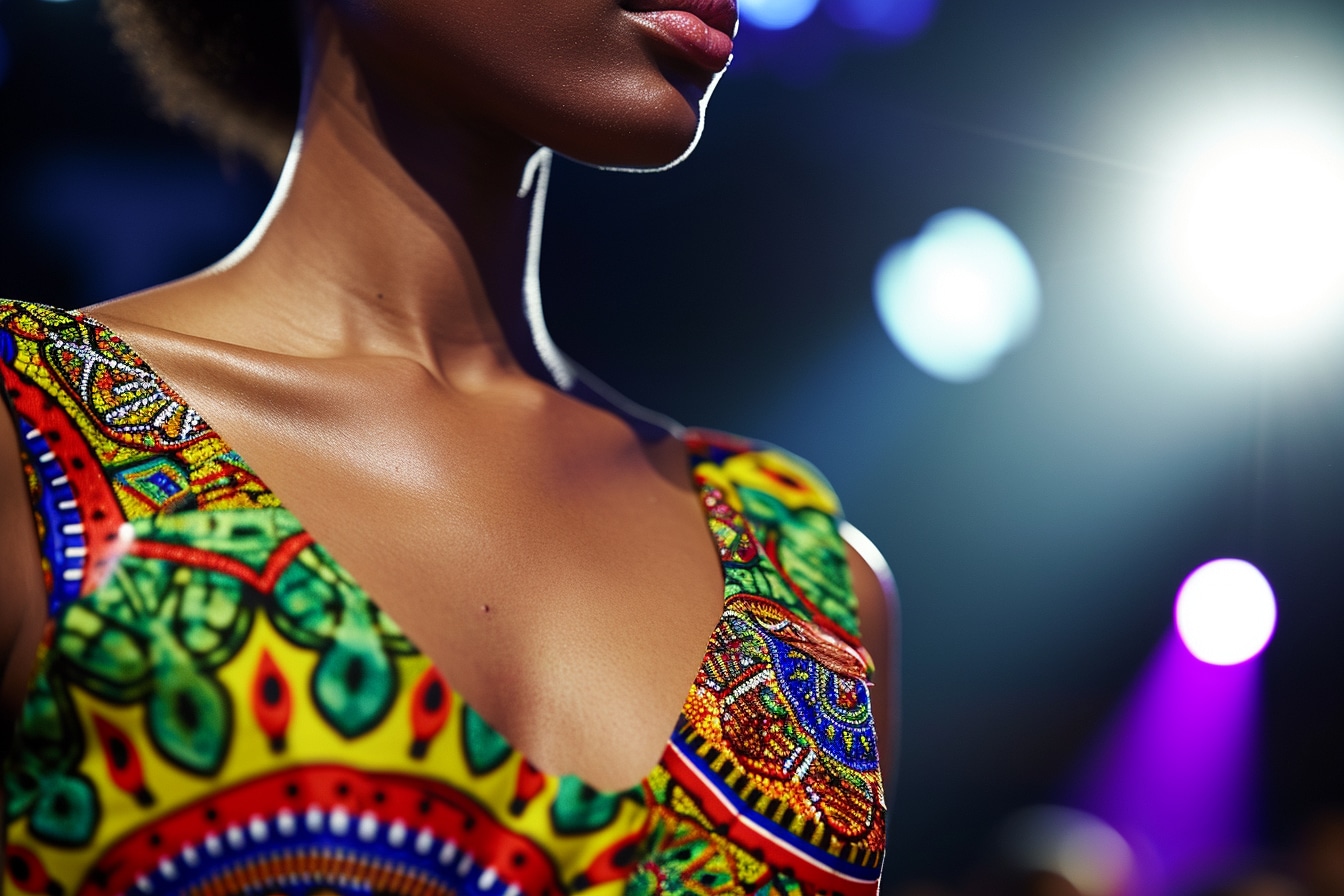We begin by exploring wax and bazin, African garments that are making their way to global fame. We’ll then look at how haute couture is integrating traditional African garments and accessories, enriching its collections. Finally, we highlight the decisive role played by African designers in the international influence of their authentic, avant-garde fashions. Take a look at the African fashion website and get to the heart of this trend that’s redefining haute couture.
African fashion transcends borders and boldly takes its place on haute couture catwalks. It manifests itself as much through the presence of emblematic fabrics as through the incorporation of traditional elements, thus participating in a cultural fusion in the fashion universe. This boom is all the more marked thanks to the emergence of African designers who, with finesse, combine heritage and modernity.
Wax and bazin: African fabrics on the catwalk
The chromatic exuberance of wax and the nobility of bazin are making bold inroads into the world of haute couture. These fabrics, once confined to local markets and traditional African ceremonies, are now enjoying phenomenal success on the international fashion scene. Proven designers are drawing on wax’s undeniable wealth of patterns and vibrant color palette to breathe new vitality into their collections. Gifted with remarkable resilience, this fabric lends itself admirably to structured cuts and offers a fertile ground for artistic expression.
Equally prestigious, bazin echoes the elegance inherent to the African continent. This textile, renowned for its ceremonial feel and refined texture, is treated with respect by haute couture houses, who recognize its strong added value. It transcends borders, embellishing evening gowns and tailored ensembles with a touch of subtle sparkle. Designers exploit its intrinsic beauty to create majestic pieces that celebrate Africa’s rich cultural heritage. Bazin is the material of reference for creating statutory African garments that reveal you belong to the upper echelons of society.
Beyond their captivating aesthetics, these fabrics embody a dialogue between tradition and modernity; they offer a visual narrative opening onto an inclusive fashion where each garment tells a singular story. On the catwalks of Paris, New York and Milan, wax and bazin resonate as emblems of a plural identity, inviting designers and spectators to a sensory journey that transcends geographical boundaries.
Incorporating traditional garments and accessories into haute couture
At the crossroads of worlds, the harmonious incorporation of African ornaments and adornments typical of African garments into the exclusive sphere of haute couture marks a significant aesthetic turning point. This assimilation, far from being anodyne, bears witness to a profound search for symbolism and history in the creations presented on the catwalks. Traditional African outfits, charged with cultural identity, are shaping a trend where each piece interweaves container and content: timeless aestheticism meets age-old craftsmanship.
We attend fashion shows where the boubou, revised by the skilful hand of an avant-garde stylist, floats majestically alongside Chanel suits. Maasai beads, veritable multicolored prisms, captivate their audience when transformed into elegant necklaces or wrapped around manicured wrists as chic bracelets. Designers also regularly infuse the spirit of the continent through sculptural Peulhes headdresses that soar high, transforming mannequins into modern totems.
In this relentless quest for renewal, Africa’s rich sartorial heritage finds new expression. Ghanaiankente is transformed to decorate slender dresses, while the iconic Fulani hat adds a singular touch to a sober silhouette. Even in the elitist enclave that is haute couture, the vibrant dialogue between this ancestral heritage and contemporary minimalism not only creates a striking visual effect, but also underlines the appetite for deep roots that fortify the fabric of tomorrow.
This movement cannot be seen as a mere passing trend; rather, it represents an opulent passage where each garment tells a story, a tale of belonging, innovation and, above all, mutual respect between two once distinct universes. The idea that the silky folds of a skirt or the embroidered curves of a bag embody centuries of immeasurably rich creation flourishes.
African clothing and its influence on international fashion
The meteoric rise of African designers in the haute couture arena marks an era of stylistic renewal that honors textile traditions while injecting a breath of modernity. Names such as Alphadi, Oumou Sy and Imane Ayissi are proudly embracing their African heritage and making a name for themselves on the catwalks of Paris, Milan and New York. These artisans of chic are redefining contemporary aesthetics with their inspired hands, drawing on a rich cultural heritage.
Their collections are brimming with references to ancestral codes revisited with audacity: where loincloth meets avant-garde cuts, where Ghanaian Kente or South African Shweshwe sport structured silhouettes evokingtimelessness. This phenomenon is more than just an ephemeral success; it reflects a quest for authenticity mingled with a global consciousness in the luxury sector. These fashion visionaries are not only designing clothes, but also mapping out a new horizon for an“Afro-global” aesthetic that appeals to a diverse audience.
Importantly, these notable contributions are also driving significant socio-economic change in Africa. Young local talents draw inspiration and know-how from these style giants, while theemergence of platforms such as Dakar Fashion Week, Lagos Fashion Week and Africa Fashion Week London showcase these talents on the international stage. By promoting a positive, dynamic image of the continent, they pave the way for deserved recognition, while stimulating the local economy by promoting“Made in Africa”.
Ultimately, the growing influence of African designers not only reflects their ingenuity, but is symptomatic of a profound mutation within the very exclusive field of haute couture, which is now enriched byplural influences that invite dialogue between different cultural narratives through African garments blending with Western wardrobes.
We recommend these other pages:
- Is African fashion represented on international catwalks?
- Which haute couture designers have been inspired by African fashion?
- Is African fashion well received on haute couture catwalks?
- What challenges do African designers face on the haute couture catwalk?
- Are there any specific events dedicated to African fashion in haute couture?

